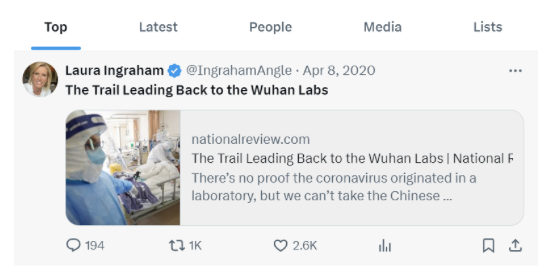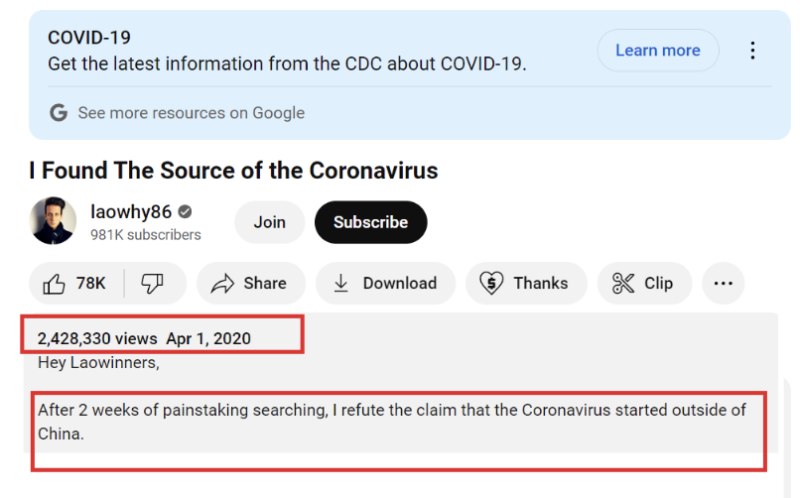Matthew Tye, an independent documentarian with a chronicled decade of living in (and motorcycling throughout) China, developed a profound understanding of its culture and language. In March 2020, Tye emerged as a singular figure in the scrutiny of the origins of the Covid-19 virus, using primary sources such as job postings and communications between Chinese researchers – putting to shame a New York Times reporter’s top-down approach of channeling Dr. Fauci (who himself may have been channeling CCP agitprop).
Yet despite Tye’s intricate and subtle discoveries linking the Wuhan Institute of Virology to the outbreak, his word didn’t travel much further than his own YouTube channel – along with one National Review article that similarly did not reverberate beyond its own innate viewership. This scenario underscores a poignant irony: in a digital age where (mis)information can circulate the globe instantaneously, platforms that could have amplified truth – Google, Facebook, Twitter – and the CDC – became custodians of silence, diverting public gaze from the “inconvenient truths” of China’s duplicity and the American deep state’s complicity – during the pandemic’s early days.
Before the pandemic reshaped global narratives, Tye was known for his engaging videos that captured the essence of living in China. He shared insights ranging from cultural explorations like Mahjong and the perceptions of tattoos in Chinese society, to more profound observations about the places where Chinese millionaires aspire to live in the US, and even a quest for China’s rumored “white people.” His documentaries and motorcycle journeys through China’s most remote and fascinating locales revealed China through an unfiltered lens.
Tye, deeply integrated into life in China through marriage and fatherhood, found himself compelled to leave the country in haste in 2018. This decision came after a chilling revelation: the public security bureau in Huizhou was circulating his photo, making him a target – due to his involvement in drone photography, albeit through Chinese contractors.
Relocating to California, Tye’s unique perspective on China’s restrictive policies intensified his curiosity about the pandemic’s origins in early 2020. Amidst rampant speculation, his fluency in Chinese, and a decade of cultural immersion enabled him to explore overlooked open-source data, distinguishing him from those content with merely accepting information as presented.
Tye’s scrutiny of China’s coronavirus response, detailed in his January 2020 critique “China Doesn’t Have This Under Control,” stemmed from skepticism of China’s motives and practices after long personal experience with both. Tye highlighted the country’s counterfeit N95 masks, censorship, hasty (and shoddy) construction of instant hospitals, hypocritical approach to travel restrictions; locking down its own cities while exporting the infected to Europe. Tye was unflinching in his analysis.
In a climate where the Chinese government was vigorously attempting to deflect inquiries into the virus’ origins, suggesting Italy, Russia, or elsewhere, Tye focused on the “metadata” resting only slightly below the surface, accessible to the curious, e.g. the enigmatic disappearance of 21 million cellphone subscriptions in China’s coinciding with the onset of strict lockdown measures; and discrepancies in Covid-19 statistics between China and open societies.
In late March 2020, he delved into the Wuhan Institute of Virology’s online presence, where he uncovered job postings and discussions from November 2019 that hinted at research on bat coronaviruses with potential human transmission. His most startling discovery in April 1, 2020’s “I Found The Source of the Coronavirus” involved a researcher who vanished from public view, with only opaque reassurances from the institute regarding her well-being. These findings were significant not just for their content but for the method of discovery; Tye relied on straightforward internet searches, bypassing the layers of censorship and obfuscation that can hinder such inquiries to China itself.
National Review’s Jim Geraghty did a thorough appraisal (April 3, 2020) of (the improbable) Matthew Tye’s groundbreaking findings:
“It is understandable that many would be wary of the notion that the origin of the coronavirus could be discovered by some documentary filmmaker who used to live in China [yet] a great deal of the information that he presents, obtained from public records posted on the Internet, checks out.”
“On December 24, 2019, the Wuhan Institute of Virology posted a second job posting, “long-term research on the pathogenic biology of bats carrying important viruses has confirmed the origin of bats of major new human and livestock infectious diseases such as SARS and SADS, and a large number of new bat and rodent new viruses have been discovered and identified.— which Tye contends meant, “we’ve discovered a new and terrible virus, and would like to recruit people to come deal with it.””
“He also contends that “news didn’t come out about coronavirus until ages after…doctors in Wuhan knew that they were dealing with a cluster of pneumonia cases…(The Chinese government waited three weeks before it) notified the World Health Organization of a “mystery pneumonia”.””
Moreover, Mr. Geraghty notes, “Scientific American verifies much of the information Tye mentions about Shi Zhengli, the Chinese virologist nicknamed “Bat Woman.”“
Despite the impactful nature of his findings, Tye’s work attracted zero “mainstream media” recognition.


The New York Times, CNN, BBC, and the Wall Street Journal have never referenced or mentioned his contributions. Jack Dorsey’s Twitter (FBI-collaborative Vichy regime) nominally allowed but likely stifled his scoop’s spread. The largest retweet Tye’s discovery (via NR and Laura Ingraham) got was a mere 2.6K retweets.


Fortunately, Matthew Tye had done a reasonable job of building his channel (founded in 2012) to 1 million subscribers. The smoking gun, “I Found The Source of the Coronavirus” video has 2.4 million views (but still appends a CDC banner, ironically).


His YouTube channel’s residuals represent his sole means of support (along with Patreon). And, boy does he need it! China is very well able to recognize any thorn in its side and retaliate appropriately. There are a number of vloggers’ casting aspersions on his reputation, incessantly scouring his 653 videos for ad hominem shots. China took the direct approach of offering him a stipend to soften his approach. Upon his refusal, the CCP pivoted: as Matthew Tye explains, “The CCP Stopped All Brands From Working With Me,” pressuring “companies not to work with people critical of the communist party of China.”
Paul Wolfowitz and Bill Drexel commented in CNBC July 13, 2021:
“Tye receives a constant barrage of online harassment, most recently in the form of English-language CCP shills attempting to portray him as a white supremacist. But Tye has also encountered CCP censorship within the U.S.: while these same shills have their popularity artificially inflated by bots and wumao (“the 50 Cent Army,” reportedly paid RMB¥0.50 /post), China’s wumao also found ways to demonetize Tye’s videos on YouTube — throttling their view count and revenue.”
Remarkably, the Chinese media have sought to counter his influence by promoting a look-alike American to disseminate pro-China commentary, an effort to muddle perceptions and discredit Tye.


The doppelgänger lacks Tye’s insight and charisma, falling short of China’s past successes in brand mimicry. This misstep isn’t just a failed attempt at replication; it’s emblematic of a deeper irony. Once, China transformed from knockoff king to luxury label owner, turning ‘Made in Italy’ into a lucrative venture: purchasing high-end Italian brands; transplanting 250,000 workers – this irony came full circle when China exported Covid-19 cases direct to Milan. In early 2020, Wuhan residents were prohibited from traveling elsewhere within China, but NOT abroad – a policy that uncaringly transplanted the crisis.
Matthew Tye’s work cuts through the modern trend (both in journalism and intelligence-gathering) of reliance on remote technologies and “chatter” for insights. Tye embodies the essence of investigative journalism: direct, human-centric inquiry. His journey across China, engaging directly with its people and culture, provides a depth of understanding and insight that remote observation cannot replicate. His ability to uncover significant information about the early stages of the Covid-19 pandemic, armed with little more than dedication and direct observation, sets a powerful example for both journalists and intelligence agencies alike. A private military intelligence support group, NSI, did hire him for its speaker series in 2022. This recognition suggests a possible reconsideration of the imbalance between technology-driven and human-centric methods of understanding our world.
Matthew Tye, a modern-day Renaissance man with an insatiable curiosity for knowledge, embodies the spirit of those who discover profound truths not through targeted pursuit but by virtue of their expansive interests and experiences. Like the amateur, Michael Ventris, who deciphered Linear-B, Tye’s journey into the heart of China – fueled by a passion for exploration, whether cruising on his motorcycle, embracing the culture, or building a family – was never aimed at uncovering any secrets, let alone the enormously consequential origin story of a global pandemic.
Yet, it was this very openness and his immersion in what he describes as the “Gray Zone” of 1990s-2000s China – a time of burgeoning commerce and interaction – that ultimately positioned him to discern the shift towards a “Red Zone” of increased paranoia and restriction beginning around 2013, emblematic of the later Chinese government’s approach to Covid-19.
Tye’s departure from China, propelled by the government’s growing suspicion, marks a poignant end to his exploration but also highlights the critical insights gained from a life lived in earnest curiosity. His story not only sheds light on the changing dynamics within China but also on the invaluable contributions of those who navigate the world with open hearts and minds, revealing truths that shape our understanding of global events.
Join the conversation:


Published under a Creative Commons Attribution 4.0 International License
For reprints, please set the canonical link back to the original Brownstone Institute Article and Author.









